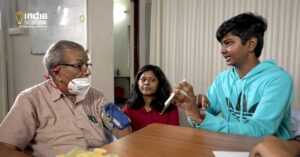IIT-Hyd Builds Device That Detects Heart Attack, Cardiac Ailments Within Minutes!
Of great importance for critical care in medical emergencies, this portable sensor has the potential to save many lives! #IIT #Innovation

Collaborating with institutions around the world, researchers at IIT-Hyderabad, led by Professor Renu John, the HOD of the Department of Biomedical Engineering, are developing biomarker-based biosensors that can detect heart disease within minutes with greater reliability and sensitivity.
In a study published by The Lancet last year, it was found that heart ailments caused more than 2.1 million deaths across age groups in 2015, accounting for more than a quarter of all deaths.
Check out Dozee, a contact-free smart health monitor that simply slips below your mattress and silently tracks your heart health, respiration, sleep quality, and stress levels
That is how critical the research work led by Professor Renu John is.
“Conventional biosensing includes such techniques as ELISA, chemiluminescent immunoassay and radioimmunoassay. We have basically developed electrochemical sensors,” says Professor John.
What are biomarkers and biosensors?
Biomarkers are biological molecules that represent health and disease states. They are specific chemicals that are released in the body in response to certain physiological conditions. Cardiac troponins or cTns, for example, are biomarkers of heart diseases and are conventionally detected in the bloodstream using antibodies that bind specifically to them, says an official press release.
Biosensors are devices that combine the sensing element (e.g. antibody) with a transducer that converts the interaction of antibody into an electrical or optical signal that can be measured, the release goes onto state.
“Research into Biosensors is coming up in a big way. For example, Biosense Technologies, a startup based out of IIT-Bombay, is developing biosensor kits for detection of glucose levels in the blood. Similarly, this is one of the biosensors, which is very important in emergency and critical care conditions. It could be used for instantaneous detection of heart attack and other cardiac diseases. Microfluidics-based biosensors can enable portable analytical devices that can provide almost instantaneous results compared to long-drawn-out lab-tests. This is where the particular advantage of our work stands. We have demonstrated very high sensitivity and very low detection limit of troponins (when the heart is damaged, it releases troponin into the bloodstream) in blood. All you need is a drop of blood on the sensor,” adds Professor John.

So, what is microfluidics?
It is the “science of manipulating and controlling fluids, usually in the range of microliters (10-6) to picoliters (10-12), in networks of channels with dimensions from tens to hundreds of micrometres,” says Fluigent, a company working in the same field.
Addressing the media last month, Professor BD Malhotra from Delhi Technological University spoke about the limitations of conventional methods used to detect heart diseases.
“The major issue with the conventional assays for the detection of cTns relates to poor sensitivity and limit of detection. Improvements in detecting biosensors such as cTns in the blood require improvements in the design of the biosensor.”
He went on to add that microfluidics-based biosensing could have very positive implications across areas like biological engineering, biomedical studies, point-of-care diagnostics, and environmental monitoring.
How does it work?
“Prof Renu John’s team and collaborators from IIT Kanpur, Zoological Survey of India, Iowa State University and Delhi Technological University, used hollow nickel vanadate nanospheres, modified with chitosan and loaded with antibodies of cTns in a microfluidic setup. When blood containing the CVD biomarker cTns was passed through the biofluidic setup loaded with the biosensing nanospheres, cTns binds with the antibody and induces an electrical signal in the nanosphere, which is then detected,” says a recent press release.
Where is the research at?
“We have demonstrated the platform, and have a proof of concept working prototype. We have also done a set of chemical validation with potential clinics, from where we have drawn the serum samples from patients there, tested it and shown that it works, besides comparing the results with those of conventional chemiluminescence assays. Of course, there is a long way to go before we can market it. However, it has gone out of the research lab and demonstrated its applicability in patients,” says Professor John.
To conclude, these biosensors can detect cTns levels as low as 0.000000000005 grams in one millilitre of blood, which makes them a very useful tool for the detection of cardiovascular maladies.
Imagine if we could inculcate this into our public health system, and the lives it could save?
The potential is immense.
Also Read: Built by IIT Grads, This Contact-Less Innovation Can Detect Heart Disorders as You Sleep!
(Edited by Gayatri Mishra)
Like this story? Or have something to share? Write to us: [email protected], or connect with us on Facebook and Twitter.
This story made me
- 97
- 121
- 89
- 167
Tell Us More
We bring stories straight from the heart of India, to inspire millions and create a wave of impact. Our positive movement is growing bigger everyday, and we would love for you to join it.
Please contribute whatever you can, every little penny helps our team in bringing you more stories that support dreams and spread hope.



















